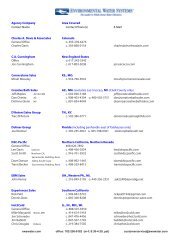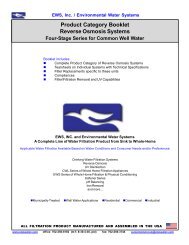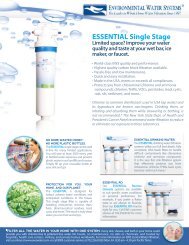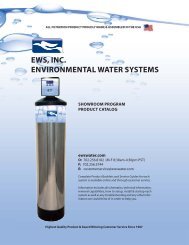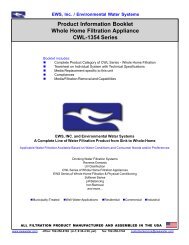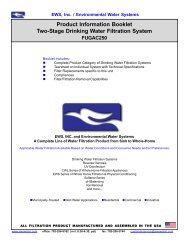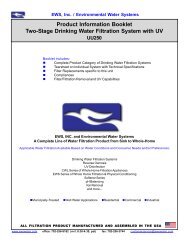EWS-1054 - Environmental Water Systems
EWS-1054 - Environmental Water Systems
EWS-1054 - Environmental Water Systems
You also want an ePaper? Increase the reach of your titles
YUMPU automatically turns print PDFs into web optimized ePapers that Google loves.
<strong>EWS</strong>, Inc. / <strong>Environmental</strong> <strong>Water</strong> <strong>Systems</strong><br />
What do these water standards mean and how do they affect you?<br />
Most municipal water districts are attempting to do the best job of providing safe drinking water to their communities.<br />
There are many issues concerning our health and that of our families. Air, water and food supplies are all suspect. It is<br />
our goal to make some sense of water issues and provide information, in order for consumers to make educated<br />
decisions.<br />
The following are excerpts from the standard language provided to consumers requesting information about their water<br />
supply in their community. This is a great place to start because it sets the table for a good general understanding of<br />
water issues and how we may compliment the water through filtration or reduce any particular issues of actual concern.<br />
Contaminants that may be present in source water include:<br />
Microbial contaminants, such as viruses and bacteria, that may come from sewage treatment plants, septic systems,<br />
agricultural livestock operations, and wildlife.<br />
Inorganic contaminants, such as salts and metals, that can be naturally-occurring or result from urban storm water<br />
runoff, industrial or domestic wastewater discharges, oil and gas production, mining, or farming.<br />
Pesticides and herbicides, that may come from a variety of sources such as agriculture, urban storm water runoff, and<br />
residential uses.<br />
Organic chemical contaminants, including synthetic and volatile organic chemicals, that are by-products of industrial<br />
processes and petroleum production, and can also come from gas stations, urban storm water runoff, agricultural<br />
application, and septic systems.<br />
Radioactive contaminants, that can be naturally-occurring or be the result of oil and gas production and mining activities.<br />
All municipally-treated drinking water is subjected to extensive testing, not only for regulated contaminants, but also for<br />
non-regulated as well. For example, the Cities of Vacaville, CA. and Las Vegas, NV. performed more than 70,000 tests<br />
on water samples throughout the year, which is typical of most water districts. <strong>Water</strong> districts also conduct source<br />
<strong>Water</strong> Assessments and Vulnerability Studies. This study evaluates the quality of the water used as drinking water<br />
supplies for local communities. The assessment survey examines activities associated with the specific waterway and<br />
surrounding areas to determine potential contaminiation. Any potential contributors are then compiled into a Vulnerability<br />
Summary.<br />
Now, what is a local door-to-door water salesman going to test for?<br />
Usually, the naturally-found calcium and magnesium minerals, which are not contaminants (see water standards) in<br />
order to “pitch” a water softener. A reverse osmosis system will be added to the “pitch”, in order to remove the salt, the<br />
softener put in, so you have something to drink! Interesting to note, those assessment studies have been making<br />
recommendations in over 30 states to restrict softeners due to the brine discharge. The use of reverse osmosis<br />
systems have been questioned. They are greatly misapplied and can waste up to 20 gallons of rejection water for every<br />
gallon of water produced.<br />
<strong>Water</strong> in the News<br />
Security is an issue that conerns us all. Federal, State and Local Agencies, partnered with the various water agencies,<br />
are taking precautionary measures to provide safe, clean drinking water to their citizens.<br />
However, a toxic chemical introduced into a municipal system would dissipate over millions of gallons of water rendering<br />
it harmless.<br />
The Flavor of the Day, Chromium, Arsenic, MTBE, Trihalomethanes (THMs) are samples of many items that may create<br />
issues with our water supplies.<br />
Ironically, chlorine used to disinfect our water, is one of the most toxic chemicals on any list.<br />
You can smell and taste it and easily test for it. It is the reason most people buy bottled water or filter at the sink. <strong>EWS</strong><br />
can filter the chlorine and the associated volatile organic compounds (VOC’s) once the chlorine has disinfected the<br />
water.<br />
Special Information<br />
Some people may be more vulnerable to contaminants in drinking water than the general population. Immuno-compromised<br />
people such as those with cancer undergoing chemotherapy, people who have undergone organ transplants,<br />
people with HIV/AIDS or other immune system disorders, some elderly, and infants can be particularly at risk from<br />
infections. These people should seek advice about drinking water from their health care providers on appropriate means<br />
to lessen the risk of infection by Cryptosporidium and other microbial contaminants.<br />
Most people simply want better tasting water, others have greater concerns.<br />
<strong>EWS</strong> Filtration to the whole home takes care of the chlorine and VOC’s and is a great compliment to most municipal<br />
water for most people. <strong>EWS</strong> Filtration to the whole home is also a healthier water environment for skin, hair and body<br />
systems due to absorption and inhalation. However, specific sink applications are available, and can be combined with<br />
whole home filtration for specific problems or concerns at the sink for drinking, cooking and other uses.<br />
www.ewswater.com office: 702-256-8182 (m-f; 8:30-4:30, pst) fax: 702-256-3744 customerservice@ewswater.com




